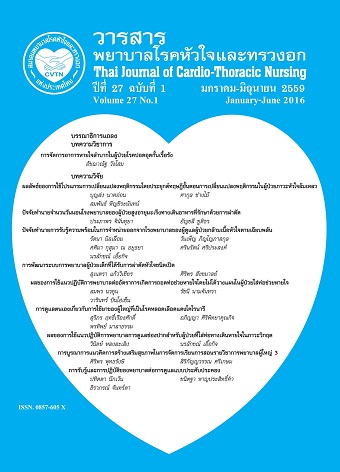การดูแลตนเองเกี่ยวกับการใช้ยาของผู้ใหญ่ที่เป็นโรคหลอดเลือดแดงโคโรนารี
คำสำคัญ:
การดูแลตนเอง, การใช้ยา, โรคหลอดเลือดแดงโคโรนารี, self-care, medication use, coronary artery diseaseบทคัดย่อ
การวิจัยนี้เป็นการวิจัยเชิงบรรยาย เพื่อศึกษาความสามารถและพฤติกรรมการดูแลตนเองเกี่ยวกับการใช้ยา และปัญหาในการใช้ยาของผู้ใหญ่ที่เป็นโรคหลอดเลือดแดงโคโรนารี โดยใช้ทฤษฎีการดูแลตนเองของโอเร็มเป็นกรอบแนวคิด เลือกกลุ่มตัวอย่างวัยผู้ใหญ่แบบเฉพาะเจาะจงจำนวน 82 ราย ที่มารับการตรวจที่แผนกผู้ป่วยนอกอายุรกรรม โรงพยาบาลมหาวิทยาลัยแห่งหนึ่ง เครื่องมือที่ใช้ในการวิจัยประกอบด้วย แบบบันทึกข้อมูลส่วนบุคคล แบบสัมภาษณ์การดูแลตนเองเกี่ยวกับการใช้ยา และแบบสอบถามปัญหาการใช้ยา วิเคราะห์ข้อมูลโดยใช้สถิติบรรยาย และวิเคราะห์ข้อมูลจากการสัมภาษณ์โดยใช้การวิเคราะห์เชิงเนื้อหา
ผลการวิจัยพบว่า กลุ่มตัวอย่างส่วนใหญ่เป็นเพศชาย (ร้อยละ 76.8) มีอายุระหว่าง 35-59 ปี (เฉลี่ย 53.3 ปี) กลุ่มตัวอย่างมีระดับความสามารถในการดูแลตนเองเรื่องยาในระดับกำลังพัฒนามากที่สุด (ร้อยละ 54.9) รองลงมาคือพัฒนาแล้ว (ร้อยละ 37.8) และยังไม่พัฒนา (ร้อยละ 7.3) ตามลำดับ กลุ่มตัวอย่างบางส่วน (ร้อยละ 12) มียาใช้ไม่ถึงวันนัด มีการใช้ยาไม่ต่อเนื่องหรือหยุดใช้ยา (ร้อยละ 21.9) เนื่องจากรู้สึกว่าตนเองไม่มีอาการผิดปกติ ลืมรับประทานยา และกลัวอาการข้างเคียงของยา แต่กลุ่มตัวอย่างบางส่วนรู้อาการข้างเคียงของยาที่ใช้ สังเกตพบอาการข้างเคียงจากการใช้ยาต่างๆ และสามารถวางแผนการใช้ยาให้เหมาะสมกับแผนการดำเนินชีวิตของตนเอง กลุ่มตัวอย่างร้อยละ 26.8 ไม่สามารถใช้ยาตามแผนการรักษาของแพทย์ได้ทั้งจำนวนมื้อ หรือขนาด เนื่องจากได้รับยาหลายชนิด และร้อยละ 7.3 มองฉลากยาไม่ชัดเจน
ผลการศึกษาครั้งนี้สามารถใช้เป็นข้อมูลพื้นฐานในการส่งเสริมความสามารถในการดูแลตนเองเกี่ยวกับการใช้ยา และนำไปวางแผนการพยาบาลเพื่อลดความคลาดเคลื่อนจากการใช้ยาในกลุ่มผู้ป่วยโรคหลอดเลือดแดงโคโรนารี
Self-care for medication use in adults with coronary artery disease
This descriptive research was aimed to explore self-care abilities and self-care behaviors for medication use, and the problems of medication use in adults with coronary artery disease. Orem’s self-care theory was used as the conceptual framework. Purposive sampling was used to recruit 82 adults with coronary artery disease attending the medical outpatient clinic of a university affiliated hospital. Data were collected using personal data questionnaires and interview guides about self-care for medication use. Descriptive statistics were used to analyze the quantitative data. The data from the interviews were analyzed using content analysis.
The result showed that most participants are males (76.8%) aged from 35 to 59 years with a mean of 53.3 years. The participants’ self-care abilities for medication use were mostly found at a developing level (54.9%), followed by the developed level (37.8%) and the undeveloped level (7.3%) respectively. Approximately, 12% of the participants had inadequate medication until the next follow-up or lost their medications. Some participants discontinued their medications for several reasons, such as no symptoms of disease, forgot to take medication, and fear of medications’ side effect. Few participants (8.5%) knew the side effects of the medications. They had observed and found the symptoms, and adjusted the medication use appropriately with their lives. Additionally, 26.8% of the participants had the problems in medication use in terms of poly-medications and 7.3% of them were unable to read the medication information.
This result would be a basic knowledge to promote self-care ability for medication use and to develop the care plan for minimizing errors of medication use in adults with coronary artery disease.
ดาวน์โหลด
รูปแบบการอ้างอิง
ฉบับ
ประเภทบทความ
สัญญาอนุญาต
บทความนี้ยังไม่เคยตีพิมพ์หรืออยู่ในระหว่างส่งไปตีพิมพ์ในวารสารอื่น ๆ มาก่อน และกองบรรณาธิการขอสงวนสิทธิ์ในการตรวจทาน และแก้ไขต้นฉบับตามเกณฑ์ของวารสาร ในกรณีที่เรื่องของท่านได้ได้รับการตีพิมพ์ในวารสารฉบับนี้ถือว่าเป็น ลิขสิทธิ์ของวารสารพยาบาลโรคหัวใจและทรวงอก






